Greeting
This is the sighted version that was marked on March 17, 2021. There is 1 pending change that needs to be sighted.
![]()
Gruss is a redirect to this article. For the actor see Marc Gruss, for the tennis player and sports official see Josef Gruss.
The greeting, the greeting formula, greeting phrase, farewell formula and farewell phrase is a formalised or ritualised gesture, phrase or other means of expression for initiating or concluding a contact. In this way, a formal distinction is made between more gestural greetings and verbalized or written greetings in interpersonal interaction.
→ Main article: Greeting (Spoken language)
The term is derived from the verb to greet, which goes back to the West Germanic grotjan - "to make talk, to make speak". Certain gestures indicate the affiliation to certain societies, associations or movements.
With the greeting, the greeter demonstrates his view of the relationship with the greeted. The forms of greeting depend on culture, time and fashion.
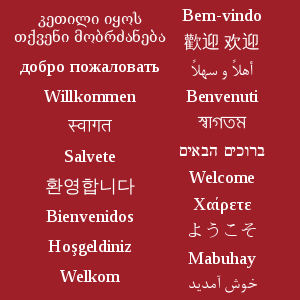
Translations of the word "welcome" can be found in many places visited by foreigners or tourists to welcome people of all nationalities
.jpg)
Welcome sign of a restaurant near Tieringen, Germany (2018).
Personal contacts
In personal contacts, greetings are verbal or gestural.
Greetings and salutations in keeping with etiquette
In Western culture, there are various sets of rules that contain norms on etiquette; they also describe the regionally different greetings and salutations. A greeting, in contrast to a salutation, involves physical contact, primarily in the form of a handshake. Excluded from the contact requirement are collective greetings of a group by a speaker. Also, behavior is considered etiquette-appropriate only when the lower-ranking person greets the higher-ranking person, a gentleman greets the lady, the younger person greets the older person, the host greets the guest first, and so on. Not greeting a person "entitled" to a greeting, who has demonstrably been seen and recognized by the person concerned, is considered impolite in Western culture. In this respect, there is also a "politeness of greeting" in civilian life to a certain extent.
In addition to rules for meeting people, there are also rules for formal farewells. In the German-speaking world, etiquette books in which the corresponding rules for greetings, farewells and other rules can be read are called "Knigge" after Adolph Knigge's main work On Dealing with People. In the Internet age, this term is also used for online rulebooks.
Language
Verbal greetings are for example "Guten Tag!", "Tag!", "Hallo!", "Grüß Gott!", "Grüß dich!" or "Grüß Sie!", "Grieß Eahna!" and "Griaß Eich" in Bavarian and in Austria, as well as "Grüezi!", "Grüessech!" (in parts of German-speaking Switzerland), "Servus!", "Valet!", "Diener!" (used in Itzgründisch), "Salve!", "Heil!", "Ave!", "Moin!", "Ahoy!" "Willkommen!", "Mahlzeit!", "Glück auf!", "Gude!", "Peace!", "Salut!", "High five" or "Hi!". The Italian "Ciao!" has also become established in the German-speaking world, as has the French "Adieu", albeit with a different meaning, namely almost exclusively as a farewell greeting, like "Tschüss".
If the greeting depends on the time of day (e.g. "Good night!"), it is called a daily greeting. In the Lötschental and in Goms (Canton Valais, Switzerland) the greeting changes four times: from early in the morning until about 8 o'clock the greeting is "Guätä Morgä!", then until around noon "güätä Tag wohl!". After lunch until about 8 pm you are greeted with "Guätä Abe!". Later it's "Good night!"
Some greetings apply to both the greeting and the farewell, so "Guten Abend!" locally can also mean that one wishes the greeted person a good night when saying goodbye. Another example in Bavaria and Austria is "Servus!", which is used for both greetings and goodbyes.
Common in central and northern Germany (and increasingly spreading to southern Germany) is "Tschüss!" or "Adschüs!", in the Rhineland "Tschö!".
In Berlin, a simple "Mojen!" is used in the morning, "Tach!" during the day and "Abend!" in the evening. (or also "'n Abend!" for "a nice good evening!") is common. However, the standard German ("hochdeutsch") greetings are becoming more widely used here as well.
In East Frisia and Schleswig-Holstein "Moin!", in Hamburg and Bremen also in the doubled form: "moin-moin!" is a greeting formula valid throughout the day (possibly a short form of Frisian "moi morn!" - literally translated: "have a nice day!").
In Switzerland, South Tyrol, Austria and Old Bavaria there is the greeting formula "bhüeti!" or "bhüeti Gott!" ("behüte dich Gott!"), in Austria, South Tyrol and Old Bavaria "pfüet di!", "pfiat di!" or "pfiat di Gott!" pronounced. In parallel, also "pfiat ina (Got)!" ("behüte Sie Gott!"), and "pfiat eich (Got)!" or "pfiat enk (Got)!" ("keep you God!").
Gestures
Among peers
- Bowing, bowing demonstrates respect.
- Shaking hands (the handshake) (Europe) expresses solidarity on an equal footing.
- Embrace as a heightened form of showing connection
- The kiss confirms a togetherness in a special way
- Derived from this is the kiss on the cheek or the rubbing together of the cheeks from the Oriental culture.
- Elbow touching became an established substitute for handshakes during the COVID-19 pandemic.
- Nodding to one another or doffing one's hat demonstrates, to varying degrees, social recognition among peers.
- The raised right open hand (attributed to the Indians) symbolizes that the greeter is peaceful (has no weapon).
- Raising the open right palm to the right front is a common military salute.
- Raising the open right hand and then touching the own left upper body (heart position) with the right fist means One Peace, One Love and is common among reggae people.
Among people of different rank
- Prostration (also: proskynesis), falling on one's feet and knees or the unilateral removal of the headgear symbolize submission
- the male servant and the female curtsy symbolize high respect
- Hands at different heights (to greet someone higher up: Hands above the head; for an equal: at head level; for a lower person: below head level).
Based on intercultural comparisons, the human ethologist Irenäus Eibl-Eibesfeldt has also described evidence for innate forms of greeting (see eye greeting).
Special forms
Other forms of greeting that have developed include:
- as (e.g. ecclesiastical) blessing the outstretched arms stretched forward
- the Victory sign, formed by the spread index and middle finger. It was popularized by Winston Churchill and became the trademark of his will to win in the fight against National Socialist Germany.
- the demonstratively raised fist of the workers' movement of the 19th century. After their division into Communists and Social Democrats, the Communists - so it is said - saluted with their right fist, the Social Democrats with their left. For the early 1930s a distinction is documented, according to which the communists held their arm at a right angle with the fist at head height, while social democrats extended their arm. As late as the
1980s, several social democratic parties wore the fist with rose as a symbol (for example, the French socialists or the Young Socialists). This symbol is still used today by the Socialist International and socialist youth organisations such as the Jusos in the SPD. - Letterpress printers, typesetters, lithographers and other "disciples of the black arts" greeted and still greet each other both orally and in writing with the letterpress greeting "God greet art", to which "God greet them" should be replied. It is worth noting that in the counter-greeting the "they" is written in lower case, because it refers to the art, not to the greeter. The introductory printer's greeting was first mentioned in print in 1740.
- The Nazis borrowed the Hitler salute or "German salute" from the salute of the fascist Benito Mussolini, who in turn borrowed his salute from the saluto romano. The more likely origin, however, is the military "salute outside closed buildings without headgear" of the Kaiserreich. However, since the dress code of the Reichswehr was changed in such a way that (military) headgear was always to be worn outside buildings and vehicles, this form of salute was "free" and was adopted by the National Socialists.
- Journeymen blacksmiths are greeted with "Cat's head?" when entering the forge and asking for work. " when entering the forge and asking for work. The journeyman's correct answer ("Piece of it! ") then decides whether he is a real journeyman or a 'windy brother', i.e. whether he is accepted or rejected.
- In the Scout salute, the three middle fingers of the right hand are extended upward to the right of the body, with the thumb over the little finger and the inside of the hand facing the opposite. A handshake is made with the left hand in each case, the hands joining not only with the bend of the thumb, but also with the cleft lying beside the little finger.
- Engine drivers, but also tram drivers and bus drivers, at least of the same company, greet each other with a raised hand while driving. Something similar was common among 2CV drivers in the 1970-1980s.
- Truck drivers sometimes greeted each other with headlights or compressor horns on the roof of the cab, at night when traffic was light, sometimes even across the median strip with a hint of flashing lights, which had the side effect of keeping them awake. Around 1980, after meeting, one might have called each other on CB radio channel 9, introduced oneself, greeted and briefly exchanged a few words.
- Other typical measures taken by (professional) drivers, on the other hand, do not primarily serve the purpose of greeting, but rather safety at blind spots: In front of curves that are difficult to see, drivers dim their lights or honk their horns to announce their presence. Postbuses in Switzerland used their own horn in front of narrow passages, especially on mountain passes.
- Motorcyclists usually greet each other by showing their left hand, the right hand remains on the throttle grip and thus ready to brake.
- Cyclists greet each other when the weather is extremely cold, the area is particularly lonely or the altitude or gradient is particularly high. Bicycle messengers also greet each other.
- Paddlers who recognize each other at least by the boat carrier on the car roof, greet each other in the area of rivers, one supports each other in the downstream car transfer.
- Mountain hikers generally greet each other in the Alps as of 1000 meters altitude.
- Windsurfers (later also surfers) greet each other with outstretched thumb and little finger ("Hang Loose")
- Rockers and metal fans often greet each other with the mano cornuta.
- Trekkies like to greet each other with the fictitious Vulcan salute: the right hand is raised, palm forward, fingers spread between middle and ring fingers.
- The nose salute (Māori: Hongi) in New Zealand is a traditional greeting where the tips of people's noses touch.
- In Eastern cultures (Japan, Korea) the simple bow is common, with numerous regional variations. The Japanese place the hands on the front of the thighs. In Korea, the hands are pressed to the sides or crossed backwards. In many South Asian and Southeast Asian countries (e.g., India - along with the word Namaste - Sri Lanka, Thailand), greeting and farewell by placing the palms of the hands vertically side by side is common (Wai).
- The salām, spoken in Arabic, is accompanied by a slight bow, with the right palm placed on the forehead. In some societies, men also embrace and kiss each other, but such gestures show a degree of intimacy and are not exchanged with strangers. All these gestures are supplemented or completely replaced by the handshake in areas where encounters with representatives of the West take place.
- Aacheners recognize each other by showing the little finger of the right hand, called "Klenkes". This greeting originates from the time of the needle makers; the straightness of the hardened needles was checked by rolling with the Klenkes.
These bows indicate respect and recognition of social rank, but not necessarily submission.
Submission
A submission is a gesture not only of politeness but also of subordination. Such gestures are less often encountered in less faceted societies; Europeans today, for example, are more likely to react with astonishment to a prostration before a human authority. The distinction between a formally polite greeting and a submission is not always easy; for example, proskynesis (Greek for "kissing the ground") has come down to us from the Greek explorer Herodotus, 5th century BC:
When Persians meet each other in the street, those of equal rank, instead of words of salutation, greet each other with a kiss on the mouth; those of different rank kiss each other on the cheek; when there is a great difference in rank, he falls down before him and pays homage to him.
After the conquest of Persia, Alexander the Great introduced Persian manners to his own court, including kneeling. Visitors, depending on their rank, had to prostrate themselves, kneel, or kiss the king. His Greek and Macedonian subjects rebelled against this practice, considering these rituals, religious to them, as belonging solely to the gods.
In countries with distinguished courtly society, bowing to nobility and royalty is customary, and the bowing is done standing. In the West, women do not bow, but perform a curtsy, moving one foot and the entire body back and lowering it while bowing the head.
More sophisticated gestures of submission were used in more formalized societies. The 叩頭 kowtow (Cantonese, literally "bumping one's head") in imperial China was a sign of deep reverence. It involves lowering the head so that it touches the ground: One begins by kneeling, sits back on the heels, moves the hands over the thighs and knees to the floor, and moves the down-tilted body forward. Whether or not the head is bowed also reflects the degree of subordination - in martial arts, for example, the head remains raised, in religious ceremonies the forehead touches the floor.
In many martial arts, as part of etiquette, salutes are given before the start of a training session or competition; in groups, lower grades salute the highest belt holder by bowing.
Religious greeting
→ Main article: Kneeling down
Many believers kneel during prayer; Catholics, sometimes Anglicans, perform a genuflection: bending the right knee, they touch the ground as a sign of worship to God. In some cases also a high church dignitary (pope, bishop) is greeted as a messenger of God with a genuflection, but then with the left knee - in order to make clear the difference to the worship of God. In Orthodox churches, instead of genuflecting, the so-called small metany is found, a bowing in which the believer touches the ground with one hand. During Islamic prayer, a kneeling bow is performed: the sujud, in which the forehead, nose, hands, knees and toes touch the ground.
In the Byzantine liturgy, standing with hands down is the posture of prayer par excellence; it expresses both reverence for God and the dignity of the worshipper as a person redeemed and exalted by baptism. Protestant and Catholic Christians rise during the service when listening to the Gospel and when saying the Lord's Prayer.
Military salute
→ Main article: Military salute
A military salute serves as a mutual mark of respect in the tradition of most armed forces, as well as in other militarily organized or uniformed institutions. It is performed in a similar manner internationally, although details vary from nation to nation.
Maritime greeting
Ships greet each other by dipping the national flag - lowering it halfway down the flagpole and hoisting it again. See also: ahoy.

Surfer's Greeting
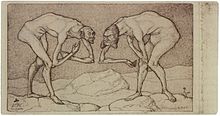
Paul Klee (1903): Two men, assuming each other to be in a higher position, meet each other
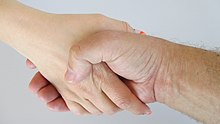
Greeting with a handshake between woman and man in accordance with etiquette
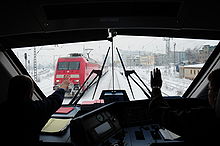
"Engineer's salute"
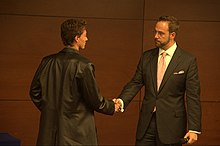
The handshake
Non-personal contacts
In telephone calls, letters, telegrams, etc., only verbal or sometimes pictorial greetings are transmitted.
Oral
Regards
In connection with Heil are often professional greetings like "Berg Heil!" (climbers), "Petri Heil!" (angler) and "Waidmanns Heil!" (hunter). To each of these one responds with "... Dank!", i.e. "Petri Dank!" etc. During the time of National Socialism, the greeting with "Heil Hitler! " was common practice.
| Greetings of different groups | |
| Group | Greetings |
| Amateur Astronomers | Clear Skies! |
| Anglers | Good luck! |
| Balloonist | Good luck, good land! |
| Ball sports (e.g. football) | Ball hoi! / Ball Heil |
| miners, speleologists | Good luck! |
| Mountaineer, Climber | Berg Heil! Berg frei! |
| Billiards | Good shot! |
| Archers | Everybody in the sheet! , All in the Gold! , All in the Kill! |
| Bowler | see skittles |
| Computer Gamers | Good luck! (gl), Have fun! (hf), Good game! (gg), also in combination: Good luck, have fun! (glhf) For players of role-playing games and shooters also Good luck, good hunt (glgh) |
| Darts player | Good darts! |
| Skydiver | Good luck! , Blue Skies and safe landings! (short: Blue Skies! ) |
| Firefighters | Good hose! Gut Weir! Gut Heil! (in parts of Austria) |
| Airman | Fractured spine and ribs! Break a leg, break a neck! Good luck, good land! Happy Landings |
| Photographers | Good light! |
| Radio amateurs | 73 |
| Geocacher | Happy Hunting! |
| Founder | Good luck! |
| Golfer | Nice game! |
| Hunter | Weidmanns! Waidmanns Heil! , Horrido! , Halali (Hunting)! |
| Bowler | Good wood! |
| Communists | Freedom! Friendship! Red Front! |
| Miniature Golfers | Nice shot! |
| Naturefriends Movement | Mountain free! |
| Paddler | Soaking wet! |
| Scouts | Good Path! Wolves: Ready at all times! |
| Cyclists | Chain right! : All clear! (Worker cyclist) |
| Rowers | Skull and cleat fracture! |
| Singer | Song up! |
| Referee | Good whistle! |
| Chimney Sweep | Good Schorn! |
| Shooters | Good shot! Schützenheil! |
| Float | Good Wet! |
| Sailor | Break the mast and the sheet! Goden Wind, always a hand's breadth of water under the keel! |
| Schafkopfspieler | Good hand! |
| typesetter, printer | God salute art! [Answer: God salute her!] |
| Skat player | Good hand! |
| Skier | Ski Heil! |
| Athletes (general) | Good sport! , Sport frei! (GDR/today still widespread in East Germany) |
| Pigeon fancier | Have a good flight! |
| Divers | Good air! , Good Wet! |
| Turner | Good health! |
| Hikers | Rise and shine! |
phone greetings
A special form of greeting can be found in telephone conversations. In the European area, different formulas of greeting can be found with which the called party answers.
Generally, one distinguishes between five different formulas:
- "Hello."
- "Yes"
- Number
- Name
- Formula
The prevalence of these formulas varies and depends strongly on the situation and environment. A significant difference can be seen in the comparison of business and private telephone calls.
"Hello" and "yes" are found pan-European, whereas calling the number has rather less use (e.g. in the UK). In Germany, Austria or Switzerland, it is common in both business and private telephone conversations for the called party to state their name first. In the context of a business telephone call, it is advisable to state the name of the company first, followed by one's own name and then a greeting (e.g. "Guten Tag!"). In this way, the caller receives all the important information about the person he is talking to. In other European countries, however, this form of greeting is more reserved for the business world.
In southern European countries or also in the Netherlands or Poland, the called party very often uses special formulas. Some examples here would be
- "Pronto!" ("Ready!") in Italy,
- "Díga (me)!" ("Speak (to me)!") in Spain or
- "έλα!", pronounced [ella], ("Yes, please!") in Greece.
Written
In written German greetings are used
- at the beginning for example "Dear Sir or Madam", "Dear Director", "Dear ...", "Dear ..." or "Hello".
- at the end, for example, "Yours faithfully", "Yours sincerely", "Many greetings" or "Kind regards".
Especially in emails, chat and SMS, emoticons are used to convey greetings.
Time-of-day-specific formulas such as "Good evening" are unusual in classical written German. They are used in e-mails, for example, if the sender can assume that the recipient will read the message at the specified time of day.
Search within the encyclopedia